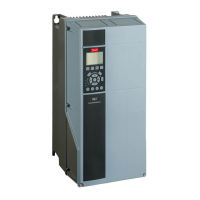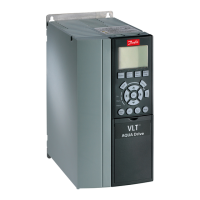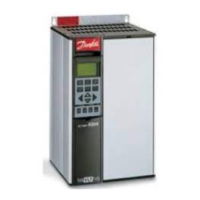η
VLT
The efficiency of the adjustable frequency drive is defined as the ratio between the power output and the power input.
Start-disable command
A stop command belonging to the group 1 control commands - see this group.
Stop command
See Control commands.
References:
Analog Reference
A signal transmitted to the analog inputs 53 or 54, can be voltage or current.
Bus Reference
A signal transmitted to the serial communication port (FC port).
Preset Reference
A defined preset reference to be set from -100% to +100% of the reference range. Selection of eight preset references via the digital terminals.
Pulse Reference
A pulse frequency signal transmitted to the digital inputs (terminal 29 or 33).
Ref
MAX
Determines the relationship between the reference input at 100% full scale value (typically 10 V, 20 mA) and the resulting reference. The maximum
reference value set in par. 3-03.
Ref
MIN
Determines the relationship between the reference input at 0% value (typically 0 V, 0 mA, 4 mA) and the resulting reference. The minimum reference
value set in par. 3-02.
Miscellaneous:
Analog Inputs
The analog inputs are used for controlling various functions of the adjustable frequency drive.
There are two types of analog inputs:
Current input, 0–20 mA and 4–20 mA
Voltage input, 0–10 V DC.
Analog Outputs
The analog outputs can supply a signal of 0–20 mA, 4–20 mA, or a digital signal.
Automatic Motor Adaptation, AMA
AMA algorithm determines the electrical parameters for the connected motor at standstill.
Brake Resistor
The brake resistor is a module capable of absorbing the braking energy generated in regenerative braking. This regenerative braking energy increases
the intermediate circuit voltage and a brake chopper ensures that the power is transmitted to the brake resistor.
CT Characteristics
Constant torque characteristics used for positive displacement pumps and blowers.
VLT
®
AQUA Drive Design Guide 1 How to Read this Design Guide
MG.20.N5.22 - VLT
®
is a registered Danfoss trademark
1-5
1

